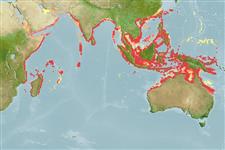>
Clupeiformes (Herrings) >
Engraulidae (Anchovies) > Engraulinae
Etymology: Stolephorus: Greek, stole, -es = garment + Greek, pherein = to carry (Ref. 45335).
More on author: Lacepède.
Environment: milieu / climate zone / depth range / distribution range
Ecologia
marinhas; estuarina; anádromo (Ref. 51243); intervalo de profundidade 0 - 50 m (Ref. 82332). Tropical (Ref. 123745)
Indian Ocean: endemic off Mauritius (Ref. 123745). Its distribution in eastern coast of Africa, from Gulf of Aden to Zanzibar, northern Madagascar, eastward to Hong Kong and Papua New Guinea (Ref. 189) is based on misidentifications for other species: Stolephorus mercurius (SE Asia), S. rex (Indo-West Pacific) and S. zephyrus (eastern coast of Africa to Madagascar) (Ref. 123745).
Comprimento de primeira maturação / Tamanho / Peso / Idade
Maturity: Lm 7.2 range ? - ? cm
Max length : 11.2 cm SL macho/indeterminado; (Ref. 123745)
Espinhos anais 0; Raios anais : 21 - 22. Diagnosis: Body somewhat compressed, belly a little rounded, with 0-5 small needle-like pre-pelvic scutes; maxilla tip pointed, reaching to or a little beyond hind border of pre-operculum, the latter convex, rounded; lower gillrakers usually 23 to 28; small teeth present on upper edge of hyoid bones; isthmus muscle tapering evenly forward to hind border of branchial membrane; pelvic fin tips reaching to below anterior dorsal finrays; anal fin short, with usually 3 unbranched and 18-19 branched finrays, its origin below second half of dorsal fin base; body light transparent fleshy brown, with a silver stripe down flank; a pair of dark patches behind occiput, followed by a pair of dark lines to dorsal fin origin (Ref. 189). It closely resembles Stolephorus apiensis of Fiji and Samoa, which lacks pigment lines before the dorsal fin; and S. brachycephalus of Papua New Guinea, which has more anal finrays, no hyoid teeth, and more scutes; Stolephorus waitei has characteristic spots on the lower part of the head, and the pelvic fins do not reach to the dorsal fin origin, as also in S. chinensis; other Stolephorus species have the hind border of the pre-operculum concave near the maxilla tip (Ref. 189).
A schooling fish found in coastal waters, apparently entering brackish water (Ref. 189), at depths of 0-50 m (Ref. 82332). It feeds on surface plankton, primarily copepods and prawn larvae (Ref. 189). Eggs are oval with a knob (Ref. 189). Used for food and fish meal (Ref. 4537).
Hata, H., S. Lavoué and H. Motomura, 2021. Taxonomic status of nominal species of the anchovy genus Stolephorus previously regarded as synonyms of Stolephorus commersonnii Lacepède 1803 and Stolephorus indicus (van Hasselt 1823), and descriptions of three new species (Clupeiformes: Engraulidae). Ichthyol. Res. 68(3):327-372. (Ref. 123745)
Status na Lista Vermelha da UICN (Ref. 130435)
Ameaça para os humanos
Harmless
Uso pelos humanos
Pescarias: espécies comerciais
Mais informação
ReferênciasAquaculturaPerfil para aquaculturaEstirpesGenéticaElectrophoresesHereditariedadeDoençasProcessamentoNutrientsConversão de massa
Ferramentas
Relatórios especiais
Baixar XML
Fontes da internet
Estimates based on models
Preferred temperature (Ref.
123201): 25 - 29.1, mean 28.3 °C (based on 1386 cells).
Índice de diversidade filogenética (Ref.
82804): PD
50 = 0.5000 [Uniqueness, from 0.5 = low to 2.0 = high].
Bayesian length-weight: a=0.00513 (0.00395 - 0.00666), b=3.18 (3.11 - 3.25), in cm total length, based on LWR estimates for this species (Ref.
93245).
Nível Trófico (Ref.
69278): 3.1 ±0.20 se; based on food items.
Resiliência (Ref.
120179): Elevada, tempo mínimo de duplicação da população menor que 15 meses (K=0.95-0.96).
Fishing Vulnerability (Ref.
59153): Low vulnerability (14 of 100).
Nutrients (Ref.
124155): Calcium = 449 [145, 1,234] mg/100g; Iron = 2.49 [1.36, 4.40] mg/100g; Protein = 19.1 [17.3, 21.0] %; Omega3 = 0.447 [0.194, 1.040] g/100g; Selenium = 46.6 [20.7, 99.9] μg/100g; VitaminA = 36.1 [7.7, 152.2] μg/100g; Zinc = 2.92 [1.90, 4.37] mg/100g (wet weight); based on
nutrient studies.
